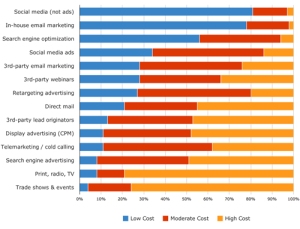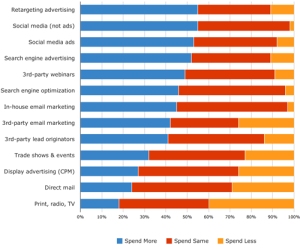How many touchpoints does it take to convert a target into a buyer?
Marketing and sales experts will often quote a common belief that it takes seven touchpoints to convert an identified target to a customer. This is a good rule of thumb for budgeting and planning. Pipeline data and analytics should confirm whether this is true within your organization.
Whether three, seven or 13 touches are required to convert a target to a buyer, the fact remains that well-coordinated touchpoint strategies between sales and marketing are critical to fully maximize the value of any investment in customer acquisition. This applies to people, methods and technology. The key to successful returns on this investment is identifying the “best” mix of touchpoints that amplify results. And this requires constant analysis, agility and oversight by sales and marketing executives.
The initial step in maximizing the impact of touchpoint strategies begins with a coordinated sales and marketing plan detailing each touchpoint used for awareness and engagement.
The touchpoints plan should outline every organized touch along the customer’s buying journey. From the initial stages of targeting and brand awareness campaigns to engagement with a sales professional, all touchpoints should be deliberate in activity, call-to-action and expectation of results. This applies to both B2B and B2C.
A touchpoint is defined as the contact made with a customer or prospect in the buying and selling process.
What are the most frequently sales and marketing touchpoint strategies used to convert a target from awareness to engagement?
- Email: Outbound, Inbound
- Phone: Outbound, Inbound
- Web: Sites, Landing Pages
- Advertising: Digital, Print, Display, Broadcast
- Social Media
- Content: News, Opinion, Blog, Online, Print
- Events: Webinars, Trade Shows, Sponsorships, Speaking Engagements, Hosted Events
- Direct Marketing: Mail, Email, Phone, Subscription
- Point-of-Sales Display and Storefronts
- Meetings: Online, In-Person
- Employees and Stakeholders
- Referrals, References and Word-of-Mouth
As you can see from the list, it is easy to find at least seven methods to reach your target audience. Each method can have multiple uses and characteristics. Experience, time, target types and cost will help determine the most effective methods for selling your products and services.
It is vital to utilize a mix of touchpoints and apply them to every single target to increase your conversion probability. Obviously, the goal is to convert with fewer touches; however, it is essential to plan for the complete mix.
Touchpoint strategies should not be left to circumstance. A touchpoint plan must answer who is responsible for each touchpoint, the medium that will be utilized, what will be said and how it will represent the brand. It needs to outline the schedule of activities and KPIs set against the expected outcomes to benchmark and measure success. Again, touchpoints should be married to the customer journey to ensure that every touchpoint is fully utilized to push and persuade the contact to buy.
A touchpoint plan should outline:
- Roles and responsibilities
- Medium
- Frequency and timing
- Key messages
- Call-to-actions
- KPIs
- Investment
Consistency in outreach, timing and messaging for all areas within the plan requires alignment to the business goals and should be shared company-wide.
One of the greatest failures is not leveraging the entire customer journey to completely benefit from all touchpoints. This happens when sales and marketing are not setting expectations on how, what and when touchpoints are utilized and who is responsible for delivery.
Resources that can help coordinate effective and consistent touchpoint strategies across an organization include:
- Company fact sheets and FAQs to ensure everyone is speaking the same language
- Brand guidelines help organizations articulate and represent the company in look and feel
- Content libraries and online resources that are maintained with the latest marketing and sales support materials
- Corporate templates for presentations, emails, marketing communications
- Marketing technologies (MarTech) and customer relationship (CRM) management platforms to help organize and manage critical touchpoints in the sales and marketing process
- Communication and event calendars to keep the organization informed of when there are opportunities to engage with key targets and customers
- Company events and training that detail the plan and set expectations for everyone’s role to support the outcomes
- Reports and dashboards that show the results of each touchpoint and ROI
Everyone in a organization sells. This means everyone should fully understand and value the sales and marketing coordinated touchpoint strategies. It is the leadership of sales and marketing that must then work hand-in-hand to ensure that the investments made into touchpoints are actualized to generate results.
We all can hope for the one touch that leads to a conversion. Those tales often are ones that are repeated in company folklore. The facts remain, it most frequently takes multiple touches to successfully convert targets to leads, then leads to buyers. Coordination between sales and marketing only increases results and impact.
Work together and expect more. Create your plan, set your targets, define your activities and measure your success. That is how you will maximize the results of your coordinated touchpoint strategies.
Jamie Glass, CMO + President, Artful Thinkers, a sales and marketing consulting company.






You must be logged in to post a comment.